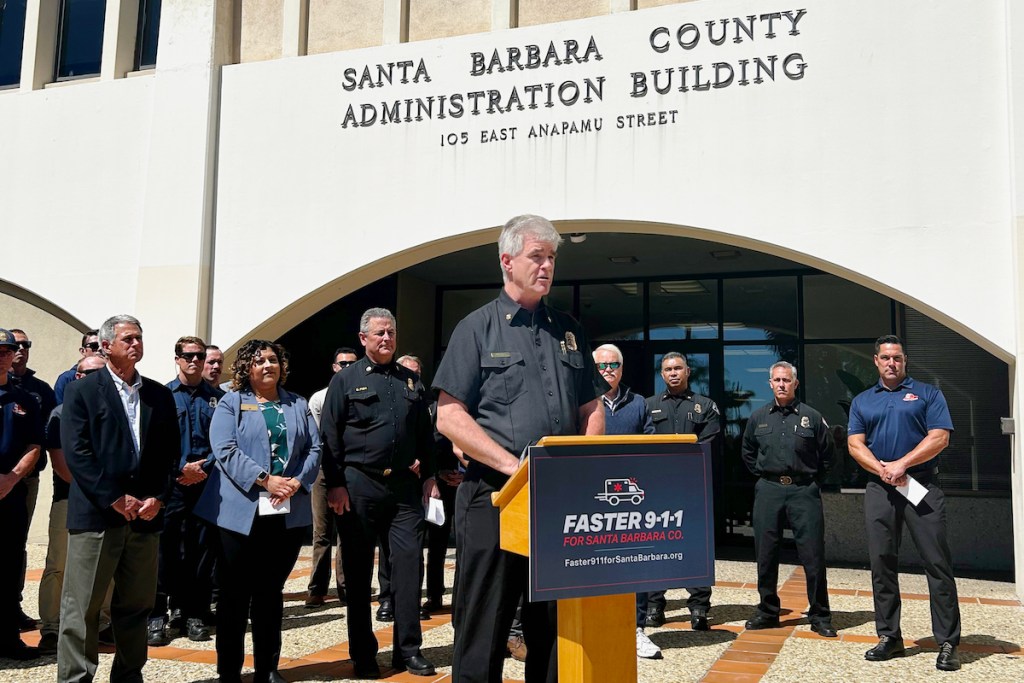In part power flex and part pep rally, more than 20 of Santa Barbara County’s fire chiefs and higher-ranking firefighters assembled Monday in front of the county administration building attired in their dress blues to enlist public support in persuading the county supervisors to award them the contract to provide ambulance and EMT services, said to be worth $1.4 billion over 10 years. That contract has been held for the past 50 years by AMR and until this past year has never been put out for competitive bid.
Chris Mailes, chief of the City of Santa Barbara Fire Department, said if the combined fire departments were awarded the contract, the county would experience a 30 percent increase in the number of ambulances with better response times. Any surplus revenues generated, he stated, would be plowed back into local operations as opposed to going into the pockets of private shareholders of a large private corporation. Mailes, who started his career as an EMT for AMR, asked for the community’s support and trust in what until this point has been an epic showdown of insider baseball.
As if on cue, Santa Barbara Mayor Randy Rowse chimed in, stating, “I don’t think that trust has to be earned; I think it’s already there.” Other elected officials joining Rowse in support of the fire agencies were Goleta councilmembers Luz Reyes-Martín and James Kyriaco. In addition, Ethan Bertrand, representing State Assemblymember and former county supervisor Gregg Hart, stood with the firefighters.
The matter goes before the supervisors next Tuesday for what promises to be a knock-down-drag-out battle.
Not addressed during the press conference was the fact that the bid proposal submitted by AMR beat out the one submitted by the fire agencies by more than 300 points. The firefighters appealed that decision up the county’s administrative food chain not once, but twice, and lost both times. AMR’s Mike Sanders later released a written statement highlighting this history, adding, “The fire district is now launching a public campaign, with allegations not based on fact, in an attempt to circumvent a multi-year process and get the decision overturned.” Sanders stressed that AMR could operate the system with no financial risk to the county and a track record of high-quality service.
The decision before the supervisors will be whether to award the contract to AMR as per the results of the county’s bidding process. It’s clear that a majority of the supervisors are unhappy with the results of that process; many question whether the right questions were asked and whether the right answers were given. Some have expressed concern that two of county administrators most immediately charged with overseeing the bidding process had previously worked for AMR. One subsequently took another job with AMR after the bid process had been agreed upon. None of the county administrators who reviewed the fire agencies’ appeal, however, had any prior work history with AMR.
Allegations of conflict of interest aside, it’s likely the supervisors will attempt to drill in on the extent to which AMR managed to respond to 90 percent of all calls for service within eight minutes, a requirement of its current contract. The fire agencies have submitted response compliance records indicating that AMR had received many exemptions and exceptions, in effect excusing the company for when it failed to make the eight-minute mark.
There was nothing illegal or surreptitious about these exceptions. Many are routinely granted when, for example, an ambulance gets blocked in a traffic jam. But without so many exceptions, the fire agencies have charged, AMR would have had a hard time complying with the eight-minute requirement called for by the contract. The fire agencies and some supervisors have objected that these exceptions have not been adequately explained.
Nick Clay — a county administrator involved with compliance review as well as the bidding process — noted that two members of the Fire Chiefs Association have sat on the county’s nine-person committee to review AMR’s compliance record for the past 18 years. Only once in that time, he said, has there ever been any serious questions raised about a compliance report. That took place in February, at a time when the dispute over the contract had reached a high pitch.
“An internal review of the process is currently being conducted,” Clay said.
Should the supervisors opt not to renew AMR’s contract come next Tuesday, the $1.4 billion question will be: then what? State law — recognizing how politically charged such important and lucrative exclusive contracts can be — restricts what the supervisors can and cannot do. (It’s worth noting that of the $144 million in billable service AMR can claim, only a small fraction is actually collected, usually 20-30 percent.)
One option making the rounds is for the supervisors to opt out of issuing an exclusive contract altogether and opening the door to both the fire agencies and AMR. While an arrangement like that’s been done in Contra Costa County for the past six years, that opens a whole other can of worms.
The county supervisors are scheduled to hear the matter next Tuesday, April 4, at about 10 a.m.

